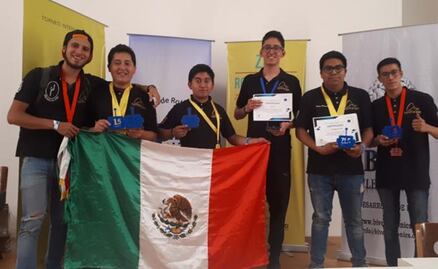Más Información

Vinculan a proceso a "El Yeicob", socio del empresario Raúl Rocha, por delincuencia organizada; le dictan prisión preventiva

Vinculan a proceso a "El Limones" por narcotráfico y posesión de armas; continúa en prisión en el Altiplano

UIF respalda sanciones de EU contra el Cártel de Santa Rosa de Lima; fortalece esfuerzos conjuntos para reducir criminalidad, destaca
From July 30 to August 4 , 32 girls and boys from different robotics programs in the states of Sonora, Campeche, San Luis Potosi, Guerrero, Morelos, Tabasco, Yucatán, and Mexico City , attended Silicon Valley, USA , in a project meant to encourage their interest in science and technology.
The participants are part of a series of robotics programs taught at the Punto Mexico Conectado , basic education schools of the Ministry of Public Education , and RobotiX centers.
The students were finalists and winners of the National Robotics Fair and the RobotiX Fair , the largest robotics competition for children in Latin America, held on June 2 in Mexico City.
The trip included a visit to the most important companies in the world for development and technology research, including the Engineering Department of Santa Clara University, Facebook, Cisco, Google, the West Coast Region Patent Office, Netflix, Great America, NASA and the Exploratorium museum .
During their stay in these companies, the children worked as a team to develop a project with social impact and had the opportunity to meet several eminent members of the technology research community.
Some of these professionals were Ali Guarneros , aerospace engineer at NASA ; Luis Vargas, of Netflix; Alfonso Ávila, software engineer at Facebook; Omar Estrada, test engineer at Google; and Maggie Ford, engineering director at the Solar Auto Project at Stanford University .
Roberto Saint Martin
, founder and director of RobotiX, pointed out that this type of program is key to encourage more and more young people to come study robotics and other disciplines while generating social awareness.
"With the help of Punto México Conectado and the Ministry of Public Education, we have been able to bring the RobotiX teaching model to more and more disadvantaged regions that were previously thought to be the last to receive technological education," he said.
"We developed the RobotiX in the Box program , through which we can take our teaching model to the classrooms of public and private schools," expressed Saint Martin
"The essence of this model is to turn common classrooms into robotic laboratories in a simple way in order to be able to implement robotics as a curricular class in basic education," explained the director of RobotiX.
dm
Noticias según tus intereses
[Publicidad]
[Publicidad]












